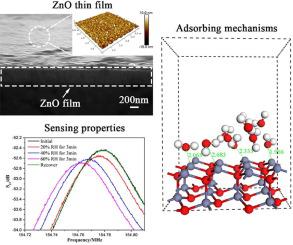Chemical Physics ( IF 2.3 ) Pub Date : 2020-06-27 , DOI: 10.1016/j.chemphys.2020.110915 Min Jin , Shuaijiang Yan , Dazhi Chen

|
In the present study, the ZnO thin film was deposited on the surface acoustic wave (SAW) chip for sensitive humidity sensors by using radio frequency magnetron sputtering method. The microstructure of the ZnO thin film was characterized by using scanning electron microscopy (SEM), atomic force microscopy (AFM) and X-ray diffraction (XRD). The ZnO film exhibited rough morphology with the average thickness of about 0.3 μm. The humidity-sensing properties of the sensors were examined by changing the relative humidity (RH) within the range of 20%–60% RH at ambient temperature. The resonant frequency shifts increased gradually with the rising of RH levels. It was found that the ZnO-SAW sensors showed high sensitivity, mainly owing to the formation of the liquid water layer and superposition effect of water molecules (WMs). Moreover, the density functional theory (DFT) calculation revealed that the adsorption and desorption of WMs on the ZnO film were physical processes.
中文翻译:

ZnO-SAW传感器表面水分子的吸附机理
在本研究中,采用射频磁控溅射方法将ZnO薄膜沉积在用于敏感湿度传感器的表面声波(SAW)芯片上。ZnO薄膜的微观结构通过扫描电子显微镜(SEM),原子力显微镜(AFM)和X射线衍射(XRD)表征。ZnO膜表现出粗糙的形态,平均厚度为约0.3μm。通过在环境温度下将相对湿度(RH)在20%–60%RH的范围内变化来检查传感器的湿度传感特性。随着RH水平的升高,谐振频率偏移逐渐增加。发现ZnO-SAW传感器具有较高的灵敏度,这主要归因于液态水层的形成和水分子(WMs)的叠加作用。此外,



























 京公网安备 11010802027423号
京公网安备 11010802027423号